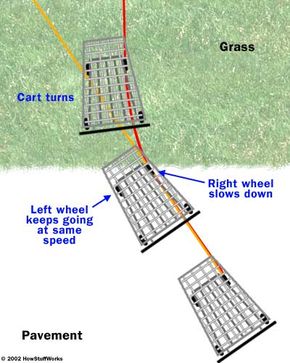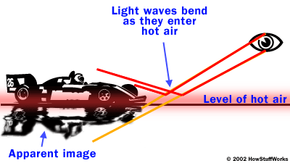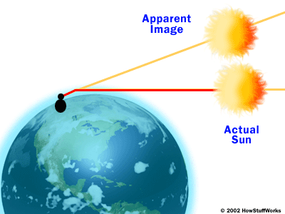In the most common type of mirage, an object appears to be reflected as if there were a pool of water on the ground. This phenomenon is caused by light refraction — the bending of light beams. Light bends when it passes from one medium into another — from air to water, for example, or even from cooler air to hotter air. This may seem like a strange idea, but it's really very simple.
Imagine you're pushing a shopping cart across a parking lot. If you're exerting a constant force, the cart's speed depends on the medium it's traveling on — in this case, the parking lot's paved surface. What happens when you push the shopping cart out of the parking lot, onto a grassy area? If you push it straight onto the grass, it will simply slow down. The grass medium offers more resistance, so it takes more energy to move the shopping cart.
But if you push the cart onto the grass at an angle, something else happens. If the right wheel hits the grass first, it will slow down while the left wheel is still on the pavement. Because the left wheel is briefly moving more quickly than the right wheel, the shopping cart will turn to the right as it moves onto the grass. Similarly, if you move from a grassy area to a paved area, one wheel will speed up before the other and the cart will turn.
A light wave works in a similar way. Its speed depends on what sort of medium it's passing through. In the vacuum of space, light travels at top speed because there isn't any matter slowing it down. It has a harder time moving through an area filled with matter, such as the Earth's gaseous atmosphere, so it moves more slowly. As it moves from one medium to another at an angle, one part of the wave changes speed an instant before the other, and the light turns.
In the next section, we'll find out how this phenomenon creates mirages.



